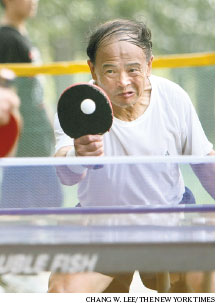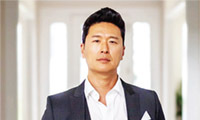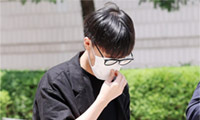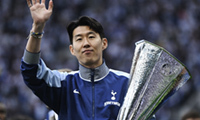[한글 번역] Ping-Pong Loses Its Allure for the Young in China

Table tennis players in Beijing parks are increasingly older. Young people prefer basketball and other sports.
By JOHN BRANCHBEIJING - On the far edge of dusk, the cicadas screeched in the eastern shadows of Chaoyang Park. But even the chorus of unseen insects, both a summer soundtrack and a delicacy in these parts, could not drown out the rhythmic metronome that has long kept the pace for free time in China. Ka-donk, ka-dink, ka-donk, ka-dink.
It was a persistent symphony of celluloid balls against rubber-sided paddles and wood tables, and the best time to see and hear it was either early in the morning or late in the day, when all 19 table tennis tables at the park are usually in use.
Players trickle in and out. They carry worn little bags made of plastic or canvas, holding the necessities of their sport - paddles, white or orange balls, netting to string across the table and a jug of homemade tea.
“And sometimes biscuits,” Ren Weiling, 61, said through an interpreter, as she pulled some from her bag.
On a couple of typical days at the park, most of the players were over 50. Men played men, men played women, women played women. Few kept score.
The players represented the fading cultural link between China and its national sport. Table tennis here is losing some of its cultural significance. Young athletes, especially, seem to be less interested in paddling a small white ball across a net.
Mao Zedong pushed the game as the primary way to show China’s strength through sports. After the International Table Tennis Federation admitted China in 1953, the Communist Party embarked on a long campaign to popularize the old English parlor game, cheap and easy to play, equally suited for crowded cities and tiny villages.
Next year will be the 50th anniversary of China’s first world championship in table tennis, won by Rong Guotuan. Zhuang Zedong followed, with championships in 1961, 1963 and 1965.
“We were all quite fascinated by the champion Zhuang Zedong,” said Zhao Chongshan, 62. He was zipping returns low across the net.
“I was in primary school, and we had a stone table,” he remembered. “We all tried to get the table to play during our 10-minute recess.”
The Chinese have won 10 men’s world titles since Mr. Zhuang’s time, including four of the last five. They are even more dominant on the women’s side, winning 17 singles titles since 1961, including 14 of the last 15. Their dominance continued at this year’s Olympic Games, where Chinese players swept both the men’s and women’s competitions.
But today, young Chinese have more options. There are movies and computers and countless other sports. Not 15 meters away from the tables here was the other side of the cultural divide.
There was a new basketball court with clear acrylic backboards. There were eight small artificial-turf soccer fields surrounded by chain-link fences. The players, all men, mostly played six on six.
Wang Zheng, 35, rested between games of basketball, talking about table tennis. He plays, but not often. “Since the ‘90s, it has become just a sport, without any special meaning,” he said.
Guo Wei, 30, had some historical perspective on why table tennis is fading in the ever-expanding Chinese culture.
“I can remember when I was 3, we had a black-and-white TV with three channels,” he said. “And we had Ping-Pong.”
From the other side of the sidewalk, a steady bass beat could just be heard , even through the back-and-forth percussion of ka-donks and ka-dinks.
It was the thump, thump, thump of basketballs bouncing on the ground.
탁구가 중국 젊은 세대에게 매력을 잃고 있다.
<존 브란치 기자>
베이징-어스름한 황혼의 끝 무렵 차오양 공원의 동쪽 그림자 아래서 매미들은 시끄러운 소리를 냈다. 그러나 여름의 사운드트랙이며 이같은 부분의 정교함인 보이지 않는 곤충들의 합창조차도 중국의 여가시간 오랜 페이스를 유지해 왔던 리드미컬한 메트로놈(박자 측정기) 소리를 지울 수는 없었다. 카-동크, 카-딩크, 카-동크, 카-딩크.
그것은 고무 모서리 패들과 나무 테이블에 부딪치는 셀룰로이드 공의 지속적인 교향곡으로, 그것을 가장 잘 보고 들을 수 있는 시간은 이른 아침 혹은 늦은 밤이었으며 공원에 마련된 19개의 탁구대가 모두 만원되기 일쑤였다.
선수들은 하나 둘 들어왔다 나간다. 그들은 플래스틱 혹은 캔버스 재질의 해어진 작은 가방을 들고 다니는데, 그 가방은 그들의 운동을 위한 필수품들-패들, 흰색 혹은 오렌지 색 탁구공, 테이블 위의 네트와 홈메이드 차가 담겨진 물주전자다.
“가끔은 비스켓도 있습니다” 가방에서 물건을 꺼내면서 61세의 렌 웨일링이 통역사를 통해 말했다.
공원의 전형적인 나날 중 하루 이틀은 대부분의 선수들이 50세 이상이다. 남자와 남자, 남자와 여자, 여자와 여자가 탁구를 친다. 점수를 기록하는 사람은 별로 없다.
이들은 중국과 그 국가 스포츠 사이의 문화적 연결이 사라져가고 있음을 상징한다.
여기에서 탁구는 문화적 중요성을 잃어버리고 있다. 특히 젊은 운동선수들은 패들로 작은 공을 쳐서 네트를 넘는 것에 별 흥미를 느끼지 못하는 것 같아 보인다.
마오쩌뚱은 이 게임을 중국이 스포츠의 강국이라는 것을 보여주기 위한 주 수단으로 밀어붙였다. 지난 1953년, 국제 탁구연맹이 중국을 승인한 이후, 공산당은 값이 싸고, 하기 쉽고, 인구가 많은 도시나 작은 동네에 모두 잘 맞는 이 오래된 영국의 휴게실용 게임을 대중화시키기 위해 긴 캠페인을 벌였다.
다음해는 중국의 롱 규오투안이 세계 탁구챔피언십에서 처음으로 우승한 50주년이 되는 해로, 장 제동이 1961년과 1963년, 1965년 우승을 하며 그 뒤를 이었다.
“우리는 모두 장 제동의 승리로 인해 매우 황홀했습니다” 올해 62세의 자오 총샨이 말했다. 그는 네트 맞은편으로 공을 낮게 맞아 치고 있었다.
“나는 초등학생이었고, 그 당시 돌로 만든 테이블이 있었어요” 그가 기억했다. “우리는 쉬는 시간 10분 동안 탁구를 치기 위해 그 테이블을 차지하려고 노력했습니다”
장의 시대 이후에도 중국은 최근 5년 중 4번을 포함, 10번의 세계 챔피언 타이틀을 거머쥐었다. 그들은 여자부의 경우 더욱 우세한데, 최근 15년간 14번을 포함해 싱글 부문 타이틀을 1961년 이후 17번 획득했다. 그들의 우세력은 올해 올림픽 경기에도 이어졌는데, 중국 선수들은 남자부와 여자부 경기를 싹쓸이 했다.
하지만 오늘날 젊은 중국 사람들은 더 많은 옵션이 생겼다. 영화와 컴퓨터, 셀 수 없을 정도로 많은 다른 스포츠들이다. 테이블의 15m도 되지 않아 문화적 경계의 다른 면이 있다.
투명한 아크릴 백보드가 달린 새로운 농구코트가 들어섰다. 체인으로 연결된 담이 있는 인공 잔디의 축구장 작은 사이즈 8개가 들어섰다. 모두 남자인 선수들은 6대6으로 경기한다.
농구경기 중간 쉬고 있던 35세의 왕 정이 탁구에 대해 말했다. 그는 탁구를 치긴 치지만, 자주하지는 않는다. “90년대 이후로 탁구가 별다른 의미 없는 스포츠의 하나로 전락해 버렸어요” 그가 말했다.
30세의 구오 웨이는 확산되고 있는 중국 문화에서 왜 탁구가 사라져가고 있는지에 대해 역사학적인 관점을 갖고 있었다.
“내가 3세 때, 채널이 3개였던 흑백 TV가 있었던 것을 기억합니다” 그가 말했다. “그리고 우리는 탁구가 있었어요”
길가의 다른 쪽에서 카-동크와 카-딩크의 치고 빠지는 진동소리 사이로 저음의 공치는 소리가 들렸다. 그것은 농구공이 땅을 치며 튀어 오르는 쿵, 쿵, 쿵하는 묵직한 소리였다.
<어휘해설>
▲cicadas: 매미
▲drown out: 소리를 지우다, 안 들리게 하다.
▲artificial-turf: 인공 잔디의
▲percussion: 진동
▲thump: 퉁하는 묵직한 소리
스마터리빙
more [ 건강]
[ 건강]이제 혈관 건강도 챙기자!
[현대해운]우리 눈에 보이지 않기 때문에 혈관 건강을 챙기는 것은 결코 쉽지 않은데요. 여러분은 혈관 건강을 유지하기 위해 어떤 노력을 하시나요?
 [ 건강]
[ 건강]내 몸이 건강해지는 과일궁합
 [ 라이프]
[ 라이프]벌레야 물럿거라! 천연 해충제 만들기
 [ 건강]
[ 건강]혈압 낮추는데 좋은 식품
[현대해운]혈관 건강은 주로 노화가 진행되면서 지켜야 할 문제라고 인식되어 왔습니다. 최근 생활 패턴과 식생활의 변화로 혈관의 노화 진행이 빨라지고
사람·사람들
more많이 본 기사
- 트럼프 “소말릴란드 아는 사람 있나?”…이스라엘 승인에 ‘NO’
- 특검, 尹에 징역 10년 구형… “법치주의·사법질서 파괴”
- “올해 최고 주목받은 테크 거물은 머스크 아닌 래리 엘리슨”
- 황하나, 마약 도피 중 캄보디아서 출산.. “아이 양육” 호소에도 구속
- 韓정부, 노란봉투법 해석 지침 공개… 하청 임금·근로조건 좌우하면 ‘진짜 사장’
- “아동 수출국 오명 벗는다” 70년 만에 해외입양 중단
- 찰스 3세, 내년 방미 추진…트럼프에 英왕실 ‘매력 공세’될까
- ‘김건희에 로저비비에 선물’ 김기현 부인 특검 재출석…곧 기소
- 한파에 고드름이 주렁주렁… 서울 이번 겨울 첫 한파주의보
- ‘정보 유출자 셀프 조사’ 경찰에 늦게 알린 쿠팡… 증거인멸 의혹
- ‘서해 공무원 피격 은폐’ 혐의 서훈·박지원 등 1심 모두 무죄
- 러, 트럼프-젤렌스키 종전회담 직전 키이우 대규모 공습
- 與 ‘통일교·신천지 특검법’ 발의… 野 “뜬금없다”
- ‘NCT 탈퇴’ 태일, 성폭행 혐의로 결국 감옥行..징역 3년 6개월 확정
- “영원한 생명 주실 승리의 하느님 오신 날”
- 특검, 김건희 ‘금품 수수’ 무더기 기소… 뇌물 여부는 경찰 몫으로
- 쏟아지는 갑질·특혜 의혹… 버티는 김병기, 속 끓는 정청래
- 김정은, 핵잠 이어 미사일 공장도 시찰
- 소싯적 ‘치기어린’ 주소 “굿바이”…지메일 주소변경기능 도입
- “새해 1호 법안은 2차특검” 정청래, 강경 기조 그대로
- 이혁재가 또.. “빌려간 3억원 안 갚아” 사기 혐의로 피소
- 미국, 美방산기업 제재한 中에 “대만 무기판매 보복 강력반대”
- 8시즌 뛰고 ML 역대 17위 “오타니 GOAT 될 것”, ML 역대 50인 선정
- 효연, 소녀시대 수입 서열 공개 “1위 나 아냐..윤아·태연이 더 벌어”
- 작년 운용자산 5조5천억달러…갑부들의 ‘패밀리오피스’ 월가 새 강자로
- LA 등 서부에 사흘째 폭우…동부엔 폭설 예보
- ‘마약 혐의’ 남양유업 3세 황하나 구속… “증거인멸 우려”
- 국제은값 폭등에 개인투자자들 銀투자 대거 유입
- [이지 사이언스] “온난화 막으려면 세계인구 44% 식단 바꿔야…문제는 소고기”
- ‘손흥민 감격의 첫 우승’ 올해 축구계 기적 톱8 선정 ‘선수로는 유일’
- 16세로 성장한 버클리 문학, 성대한 송년 파티
- “출생시민권은 사기”⋯ 이민 2세대 공격 초점 맞춘 트럼프
- 대만이슈 돌출로 美中 ‘삐걱’…내년 4월 트럼프 방중前 기싸움?
- “엔비디아, AI칩 스타트업 인수 아닌 기술 계약으로 규제 회피”
- 곽도원, 음주운전 3년 만 복귀각..스토리제이컴퍼니 측 “미팅 했지만 계약 단계 아냐”
- “온 세상에 희망·평화의 빛 스며들길”
- ‘역대 최연소’ 백악관 대변인 레빗, 둘째 임신 공개
- VA·MD 7명 생굴 먹고 식중독…22개주 60여명 감염
- ICE 버지니아 구금시설 ‘포화’…수감자 역대최고
- 쿠팡, 자체 조사결과 발표후 첫거래일 급등…뉴욕증시서 6%↑
- 위성락, 유엔 사무총장에게 방북 요청한듯…대통령실 “확인 어렵다”
- 통일교 ‘키맨’ 윤영호·송광석 재조사… ‘공소시효 난제’ 풀까
- 젤렌스키 “28일 트럼프와 종전안 논의…영토·원전 외 90% 완성”
- 린다 한 “내년 1월17일 별도 한인회연합회 만들겠다”
- 트럼프 관세에…고급 와인 시장도 ‘휘청’
- 한미장학재단에 3만달러 영구장학금 기탁
- “연말은 스트레스·새해 결심은 없다”
- 뉴욕한인회, 이번에 이사장 자리 놓고 내홍 조짐
- ‘학자금 상환’ 안하면 임금압류
- 루비오 국무장관, 트럼프가 민 온두라스 당선인과 통화… “명확한 승리”
1/5지식톡

-
 미 육군 사관학교 West Poin…
0
미 육군 사관학교 West Poin…
0https://youtu.be/SxD8cEhNV6Q연락처:wpkapca@gmail.comJohn Choi: 714-716-6414West Point 합격증을 받으셨나요?미 육군사관학교 West Point 학부모 모…
-
 ☝️해외에서도 가능한 한국어 선생님…
0
☝️해외에서도 가능한 한국어 선생님…
0이 영상 하나면 충분합니다!♥️상담신청문의♥️☝️ 문의 폭주로 '선착순 상담'만 진행합니다.☎️ : 02-6213-9094✨카카오톡ID : @GOODEDU77 (@골뱅이 꼭 붙여주셔야합니다…
-
 테슬라 자동차 시트커버 장착
0
테슬라 자동차 시트커버 장착
0테슬라 시트커버, 사놓고 아직 못 씌우셨죠?장착이 생각보다 쉽지 않습니다.20년 경력 전문가에게 맡기세요 — 깔끔하고 딱 맞게 장착해드립니다!장착비용:앞좌석: $40뒷좌석: $60앞·뒷좌석 …
-
 식당용 부탄가스
0
식당용 부탄가스
0식당용 부탄가스 홀세일 합니다 로스앤젤레스 다운타운 픽업 가능 안녕 하세요?강아지 & 고양이 모든 애완동물 / 반려동물 식품 & 모든 애완동물/반려동물 관련 제품들 전문적으로 홀세일/취급하는 회사 입니다 100% …
-
 ACSL 국제 컴퓨터 과학 대회, …
0
ACSL 국제 컴퓨터 과학 대회, …
0웹사이트 : www.eduspot.co.kr 카카오톡 상담하기 : https://pf.kakao.com/_BEQWxb블로그 : https://blog.naver.com/eduspotmain안녕하세요, 에듀스팟입니다…
케이타운 1번가
오피니언

새해 더 중요해지는 노동법 준수

연말연시, 안전하고 차분하게
 캐슬린 파커 워싱턴포스트 칼럼니스트
캐슬린 파커 워싱턴포스트 칼럼니스트 [캐슬린 파커 칼럼] 지미 라이의 마지막 희망
 유경재 나성북부교회 담임목사
유경재 나성북부교회 담임목사 [한국춘추] 미국의 힘
 전병두 서북미수필가협회 회원
전병두 서북미수필가협회 회원 [금요단상] 비자 발급
 박일근 / 한국일보 수석논설위원
박일근 / 한국일보 수석논설위원 [지평선] 스님의 주례사
 신상철 / 고려대 고고미술사학과 교수
신상철 / 고려대 고고미술사학과 교수 [미술 다시보기] 신의 모습을 닮고자 한 예술가
 스티브 강 전 한인민주당협회 회장
스티브 강 전 한인민주당협회 회장 [스티브 강 ‘인사이드 미국’] 2026 중간선거: 트럼프 지지율 하락이 말해주는 것
 김홍일 케이유니콘인베스트먼트 대표
김홍일 케이유니콘인베스트먼트 대표 [기고] 안정의 기준은 어떻게 제도가 되었나
1/3지사별 뉴스

물류거점창고에 불체자 8만명 수용 추진
도널드 트럼프 행정부가 이민자 구금·추방을 효율화하기 위해 전국 물류거점 창고에 8만명 규모의 수용시설 확보를 추진한다고 24일 워싱턴 포스트…
‘학자금 상환’ 안하면 임금압류

“온 세상에 희망·평화의 빛 스며들길”
가자지구와 우크라이나에서의 전쟁, 고립과 불평등으로 세상이 어지러운 가운데 워싱턴 지역 각급 한인교회와 성당들이 성탄절을 맞아 일제히 예배와 …
“연말은 스트레스·새해 결심은 없다”

‘손흥민 vs 메시’ 2026 MLS 개막전서 세기의 맞대결 예고
LA 풋볼클럽(LAFC)가 2026시즌 MLS 정규리그 일정을 공식 발표하며 한인 축구 팬들의 시선을 한몸에 받고 있다. LAFC는 오는 20…
[새해부터 이렇게 달라진다] 최저임금 또 오르고… 유급 병가는 더 확대

오늘 하루 이 창 열지 않음 닫기 





















































.png)


댓글 안에 당신의 성숙함도 담아 주세요.
'오늘의 한마디'는 기사에 대하여 자신의 생각을 말하고 남의 생각을 들으며 서로 다양한 의견을 나누는 공간입니다. 그러나 간혹 불건전한 내용을 올리시는 분들이 계셔서 건전한 인터넷문화 정착을 위해 아래와 같은 운영원칙을 적용합니다.
자체 모니터링을 통해 아래에 해당하는 내용이 포함된 댓글이 발견되면 예고없이 삭제 조치를 하겠습니다.
불건전한 댓글을 올리거나, 이름에 비속어 및 상대방의 불쾌감을 주는 단어를 사용, 유명인 또는 특정 일반인을 사칭하는 경우 이용에 대한 차단 제재를 받을 수 있습니다. 차단될 경우, 일주일간 댓글을 달수 없게 됩니다.
명예훼손, 개인정보 유출, 욕설 등 법률에 위반되는 댓글은 관계 법령에 의거 민형사상 처벌을 받을 수 있으니 이용에 주의를 부탁드립니다.
Close
x